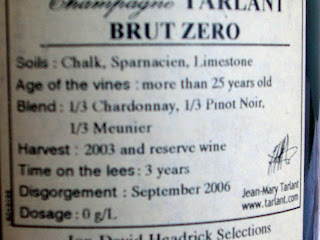Imagine a night out on the town, walking into a hip club, a couple of lovely gents or ladies at the bar, whatever your preference. It's not too loud and everyone can hear as you, in your super-cool voice tell the bartender "I'll have an apricot schnapps on the rocks." What on earth are you thinking, pal?!?
Apparently if you were to commit the above atrocity, but in Paris, you would ask for a Pineau des Charentes. When I was thinking about writing this post I asked Bert of Wine Terroirs for his thoughts about Pineau des Charentes, and this is what he said:
I'm not speaking for the whole of France but I think it's quite objective to say that Pineau des Charentes is quite out of fashion. It is associated with the image of an older person's drink living in the countryside or rural areas. It is hard to know but I think that this type of drink was selling better in the 1950s' or 1960s'. But I am not in the best position to have an opinion because I haven't had one for years and I generally don't like too much these sweet, high-in-alcohol drinks.
Bert was careful to say that he doesn't speak for the French people, just for himself. But I think Bert speaks for the French people as a whole, so there you have it - Pineau is not terribly popular among the younger set in France nowadays. I remember sitting outdoors at a cafe in the 11th in Paris with BrooklynLady a few years ago and chit-chatting with the guy next to us. The waiter came around to take orders and I asked for Pineau (BrooklynLady and I were about to go have dinner) and this guy just started laughing, like I was some sort of an ape impersonating a man ordering a drink. But I'm here to tell you that Pineau is good stuff, and that anyone who appreciates a nice aperitif should check it out. Pineau wouldn't have lasted for four centuries if it didn't taste good. And here in the US, you don't have to deal with the social connotations of ordering Pineau, as you would in France. Maybe they order apricot schnapps over there...
Pineau des Charentes is made by combining 3 parts freshly pressed grape must (juice, skins, stem fragments - must is what you get when you press grapes) with one part Cognac of at least one year of age. Legend has it that this first happened in 1589, by mistake. A grower didn't realize that the oak barrel already contained Cognac when pouring in the grape must. Five years later a huge harvest required him to empty some barrels to begin aging new wine, and he discovered this lovely new beverage, fresh, sweet, and fruity, somewhat viscous in texture, and with the deep layers of flavor that come with Cognac. Those who got to taste the drink must have liked it, because the recipe has been perfected and
Pineau des Charentes, as it is called, has been produced and consu

med in huge quantities in France ever since.
Pineau des Charentes is a fortified wine, like Port or Lillet. The alcohol in the Cognac stops fermentation in the grape must, and the natural sugars in are left in the drink. Pineau can be red when it is made from Malbec, Merlot, Cabernet Sauvignon, and/or Cabernet Franc, but in the USA it is far more common to see white Pineau, made from a host of grapes including Colombard, Folle Blanche, Ugni Blanc, and Semillion.
The first time I tasted Pineau des Charentes was in France in October of 2006 at a restaurant in Chinon. The house aperitif that night was something built around white Pineau. It was served in a rocks glass with a single square ice cube, and it was just delicious - sweet, perky with acidity, with a really nice perfume. I asked what it was, and all I understood was Pineau. So I decided to buy some when I got home.

Pineau is sweet - no doubt about it, but it can be beautifully balanced if the acidity is there and the depth and body of the Cognac is there too. And here is something that should make you feel pretty good about Pineau: adding sugar to create the sweetness is strictly forbidden. It is only the sugar from the freshly pressed grapes that brings sweetness. In other words, growers must take care with their grapes and work carefully with nature in order to make Pineau. No shortcuts involving booze and bags of Domino.
That said, there are huge Cognac houses that make Pineau, and there are smaller producers whose focus is actually on Pineau, not on using Cognac rejects to make Pineau. These are the ones to taste, if you are curious. Try, for example,
Birius, or Normandin-Mercier, Jacques Leteux, or Chevalier de Flourac if you can find them. But there are plenty more - ask and ye shall receive, if you're at a good wine or liquor shop, anyway.
I know that this post is a departure from the usual stuff that I write about, but the other night, a really chilly night, dinner was in the oven, the daughter was in bed, BrooklynLady was puttering around the house, and I felt like an aperitif. Nothing too strong because we would have wine with dinner, but just a little something. And then I remembered the bottle of Pineau I had stowed away. Chilled in the fridge for a half hour...what bright and completely enjoyable nip before dinner. So good that I felt like sharing with you, pal. I'm convinced that this is an under-appreciated drink. Try and see what you think.


















